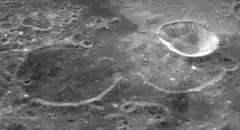 Apollo 15 mapping camera image, with Hume below center, Hume A above center, and Hume Z above left of center | |
| Coordinates | 4°42′S 90°24′E / 4.7°S 90.4°E |
|---|---|
| Diameter | 23 km |
| Depth | 0.65 km[1] |
| Colongitude | 270° at sunrise |
| Eponym | David Hume |


Hume is a small lunar impact crater that lies along the eastern limb of the Moon, along the southeast edge of Mare Smythii. It is located just on the far side of the Moon, but it is often brought into sight from Earth due to libration. Hume lies just to the west-northwest of the much larger Hirayama, and to the northeast of the flooded crater Swasey.
Hume has been flooded by flows of basaltic lava, leaving only a slender rim projecting above the surface. Its interior floor is level and has the same low albedo as the lunar mare to the northwest. The rim has a wide gap at the northern end, and the floor lies open to the exterior. This feature is not marked by any overlying impacts of note.
Hume is about 650 meters deep when measured from the high point on the southeast rim to the low point on the crater floor.[1]
Satellite craters
By convention, these features are identified on lunar maps by placing the letter on the side of the crater midpoint that is closest to Hume.
| Hume | Latitude | Longitude | Diameter |
|---|---|---|---|
| A | 3.8° S | 90.6° E | 25 km |
| Z | 3.6° S | 90.4° E | 14 km |
References
- 1 2 LTO-82A4 Hirayama — L&PI topographic map
- Andersson, L. E.; Whitaker, E. A. (1982). NASA Catalogue of Lunar Nomenclature. NASA RP-1097.
- Blue, Jennifer (July 25, 2007). "Gazetteer of Planetary Nomenclature". USGS. Retrieved 2007-08-05.
- Bussey, B.; Spudis, P. (2004). The Clementine Atlas of the Moon. New York: Cambridge University Press. ISBN 978-0-521-81528-4.
- Cocks, Elijah E.; Cocks, Josiah C. (1995). Who's Who on the Moon: A Biographical Dictionary of Lunar Nomenclature. Tudor Publishers. ISBN 978-0-936389-27-1.
- McDowell, Jonathan (July 15, 2007). "Lunar Nomenclature". Jonathan's Space Report. Retrieved 2007-10-24.
- Menzel, D. H.; Minnaert, M.; Levin, B.; Dollfus, A.; Bell, B. (1971). "Report on Lunar Nomenclature by the Working Group of Commission 17 of the IAU". Space Science Reviews. 12 (2): 136–186. Bibcode:1971SSRv...12..136M. doi:10.1007/BF00171763. S2CID 122125855.
- Moore, Patrick (2001). On the Moon. Sterling Publishing Co. ISBN 978-0-304-35469-6.
- Price, Fred W. (1988). The Moon Observer's Handbook. Cambridge University Press. ISBN 978-0-521-33500-3.
- Rükl, Antonín (1990). Atlas of the Moon. Kalmbach Books. ISBN 978-0-913135-17-4.
- Webb, Rev. T. W. (1962). Celestial Objects for Common Telescopes (6th revised ed.). Dover. ISBN 978-0-486-20917-3.
- Whitaker, Ewen A. (1999). Mapping and Naming the Moon. Cambridge University Press. ISBN 978-0-521-62248-6.
- Wlasuk, Peter T. (2000). Observing the Moon. Springer. ISBN 978-1-85233-193-1.
External links
- LTO-82A4 Hirayama — L&PI topographic map